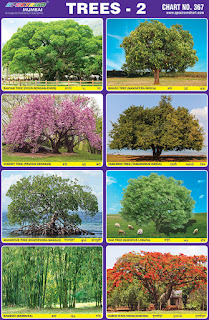 |
| Trees Chart |
Spectrum Chart - 367 : Trees 2
1. Banyan Tree (Ficus Benghalensis) -
Ficus benghalensis, with the common name Indian banyan, is a tree
which is native to the Indian Subcontinent. Specimens in India are
among the largest trees in the world by canopy coverage. Indian
banyan produces propagating roots which grow downwards as aerial
roots. Once these roots reach the ground they grow into woody trunks.
It is the national tree of India. Due to the large size of the tree's
canopy it provides useful shade in hot climates.
2. Mango Tree (Mangifera Indica) -
Mangifera indica, commonly known as mango, is a species of flowering
plant in the sumac and poison ivy family Anacardiaceae. It is found
in the wild in Bangladesh, India and Pakistan where it is indigenous
and cultivated varieties have been introduced to other warm regions
of the world. It is a large fruit-tree, capable of a growing to a
height and crown width of about 100 feet and trunk circumference of
more than twelve feet.
3. Cherry Tree (Prunus Cerasus) - Prunus
cerasus, Cherry tree is a species of Prunus in the subgenus Cerasus
(cherries), native to much of Europe and southwest Asia. The tree is
small growing to a height of 4–10 m has twiggy branches and its
crimson-to-near-black cherries are borne upon shorter stalks.
4. Tamarind Tree (Tamarindus Indica) –
Tamarind (Tamarindus indica) is a leguminous tree in the family
Fabaceae indigenous to tropical Africa. The genus Tamarindus is a
monotypic taxon, having only a single species. The tamarind tree
produces edible, pod-like fruit which is used extensively in cuisines
around the world. Other uses include traditional medicine and metal
polish. The wood can be used in carpentry. Because of the tamarind's
many uses, cultivation has spread around the world in tropical and
subtropical zones.
5. Red Mangrove Tree (Rhizophora Mangle) -
Rhizophora mangle, known as the red mangrove, is distributed in
estuarine ecosystems throughout the tropics. Red mangroves trees are
found in subtropical and tropical areas in both hemispheres. They
thrive on coastlines in brackish water and in swampy salt marshes.
Because they are well adapted to salt water, they thrive where many
other plants fail and create their own ecosystems, the mangals.
6. Oak Tree (Quercus Lobata) - Quercus
lobata, commonly called the valley oak or roble, grows into the
largest of North American oaks. Mature specimens may attain an age of
up to 600 years. This deciduous oak requires year-round access to
groundwater. The sturdy trunk of the oak tree may exceed 3 m in
diameter and its stature may surpass 30 m in height. The branches have
an irregular, spreading and arching appearance that produce a
profound leafless silhouette in the clear winter sky.
Leaves are 5 to 10 cm long and are
roundly and deeply lobed.
7. Bamboo (Bambusa) – The bamboos are a
subfamily (Bambusoideae) of flowering perennial evergreen plants in
the grass family Poaceae. Bamboos include some of the fastest-growing
plants in the world, due to a unique rhizome-dependent system.
Certain species of bamboo can grow 91 cm within a 24-hour period.
Bamboo species are found in diverse climates, from cold mountains to
hot tropical regions.
8. Gulmohar Tree or Royal Poinciana
(Delonix Regia) - Gulmohar Tree or Royal Poinciana (Delonix regia) is
a species of flowering plant in the bean family Fabaceae, subfamily
Caesalpinioideae. It is noted for its fern-like leaves and flamboyant
display of flowers. In many tropical parts of the world it is grown
as an ornamental tree. Royal Poinciana requires a tropical or
near-tropical climate, but can tolerate drought and salty conditions.
It prefers an open, free-draining sandy or loamy soil enriched with
organic matter.

No comments:
Post a Comment